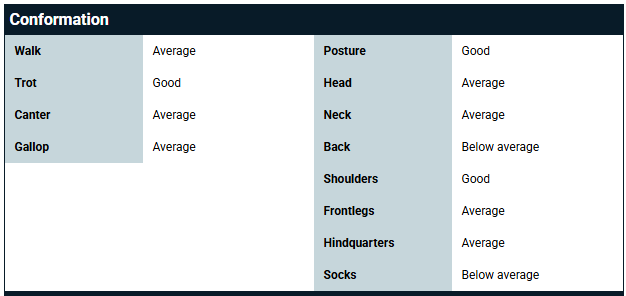¶ General
Conformation refers to the structure of a horse's body and determines how well it moves as well as its overall appearance. A horse's conformation is an important - but not the only - factor in determining how well it does in conformation shows and competitions.
¶ Conformation Stats
The conformation stats of a horse are visible from birth, as long as the horse is owned by a player or by Gisela. Only the stats of Foundation and Wildlife Park horses are hidden.
You can find the conformation stats in the tab "Stats" on a horse's profile:


The stats on the left side of the conformation box refer to the gaits and therefore movement of the horse (four for most breeds, five for Kathiawaris and six for Icelandic Horses). On the right side are eight traits that refer to the appearance of the horse’s body.
¶ Numeric Values
Each of the conformation traits has a word written next to it: poor, below average, average, good, or very good. Those words refer to a numeric value that is hidden from you:
| Value | Label |
|---|---|
| 0-39 | Poor |
| 40-59 | Below average |
| 60-69 | Average |
| 70-84 | Good |
| 85-100 | Very good |
Note: Every horse has two alleles for each trait, and the numeric value/word label refers to the average of the two. Read more about that in the Inheritance 101 article.
¶ G and G+
G+ is a popular player-made category. It is a differentiation between different "good" stats depending on the Breeder's Advice sentences:
- G+ is a high good, identified by having a "good" in the conformation box, but the best possible sentence in the Breeder's Advice
- G is a regular good, identified by having a "good" in the conformation box, but the second-to-best sentence in the Breeder's Advice
¶ Discipline-Specific Conformation
If you are training your horse for competitions, some of its conformation stats will influence its performance. You will find the complete list in the article about competitions.
¶ Breeding for Conformation - An Example
Let's assume you want to breed a foal with a “very good” conformation stat for “Head”. You pick a mare and a stallion, both with a “very good” head – but when the foal is finally born, you notice that it has only an “average” head. How can this be? Is this a bug? The game must be broken, right?! Wrong. It is simply genetics, and it might be worth your while to breed those two horses again to each other. So let us take a closer look at our imaginary mare and stallion with their “very good” heads.
You cannot be sure of the number that hides behind the label “very good” of your mare and stallion. You only know that it has to be 85 or higher. For the sake of this example, we will now assume to know the underlying numbers exactly. But in the game, you have no way of knowing these for sure. Just as in real life, all you can see is the trait as manifested in your horse and not its genetic material.
Let's assume that both the mare and the stallion have the value 85 for their heads. This is just the average of two numbers because each horse has two alleles for each gene. Let's assume further that those four alleles look like this:
| Allele 1 | Allele 2 | Trait | |
|---|---|---|---|
| Mare | 92 | 78 | 85 “Very Good” |
| Stallion | 70 | 100 | 85 “Very Good” |
If you breed a foal with these two horses, the foal will inherit one allele of its mother and one of its father – which one is entirely up to chance. Also, the alleles it inherits will receive a small roll-up or roll-down due to RNG. For the sake of simplicity, we have left this out of the example for the moment. Without RNG, there are four possible combinations:
| Allele 1 | Allele 2 | Trait | |
|---|---|---|---|
| Foal | 92 | 100 | 96 “Very good” |
| Foal | 78 | 100 | 89 “Very good” |
| Foal | 92 | 70 | 81 “Good” |
| Foal | 78 | 70 | 74 “Good” |
Depending on which alleles the foal inherits, the number that hides behind the label can range from 74 to 96. When we add RNG to the equation, it can turn that 74 into a 69, making our imaginary foal's head “average”. So the same parents that produce an average foal could also produce an excellent one - imagine what a foal it would be if RNG added more points to the best combination!
¶ Changelog
- On January 9th 2019, Conformation Stats were made visible permanently. Before this update, horses had to be entered in a Conformation Show first to reveal their Conformation Stats[1]